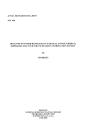The very productive lagoon fisheries of Tarawa…
The very productive lagoon fisheries of Tarawa atoll changed greatly in recent decades as human development and intensive harvesting increased. Tarawa typifies the increasingly common condition of resource depletion and marine community structure change with expanding human activities and population growth. Fisheries-dependent reports have documented the change in fisher landings for nearly two decades. A comparison of fisheries-independent data collected during 1992-93 with data collected in 1977 allowed for documentation of large changes in important finfish resources in Tarawa Lagoon. The historically important bonefish (Albula glossodonta), like other important fishery species, demonstrated declines in catch-per-unit effort (CPUE), proportion of catch, mean length and weight (1977: 46.4 cm, 1.31 kg; 1992-93: 37.6 cm and 0.84 kg), and sex ratio (1977: 0.71:1 [F:M]; 1992-93: 0.15:1). Beach seine sampling of bait fishes demonstrated a major shift in species composition between 1977 and 1992- 93, with severe depletion of some preferred species. These results suggest declining abundance in locally important fish species and large changes in species composition within Tarawa Lagoon.
Available online
Call Number: [EL]
Physical Description: 16 p.
Data and Resource
| Field | Value |
|---|---|
| Publisher | National Museum of Natural History |
| Modified | |
| Release Date | |
| Source URL | https://library.sprep.org/content/declines-finfish-resources-tarawa-lagoon-kiri… |
| Identifier | VL-34630 |
| Spatial / Geographical Coverage Location | Pacific Region |
| Relevant Countries | Pacific Region |
| License |
SPREP Public Licence
![[Open Data]](https://assets.okfn.org/images/ok_buttons/od_80x15_blue.png)
|
| Contact Name | SPREP Records and Archives Officer |
| Contact Email | [email protected] |
